Making healthier choices starts with understanding the nutritional value of the food we eat. By knowing what’s in our meals, we can make informed decisions about our diets and strive for a well-balanced nutrition plan. One important aspect of this is fresh kitchen nutrition information. Knowing the nutritional facts about the ingredients we use can help us create healthier and more nourishing meals.
When it comes to fresh kitchen nutrition information, it’s essential to be aware of the nutrients found in the ingredients we cook with. From fruits and vegetables to lean proteins, each ingredient offers a unique set of vitamins, minerals, and other nutrients that contribute to our overall health and well-being.
Key Takeaways:
- Understanding the nutritional value of fresh ingredients helps us make informed choices about the food we consume.
- Reducing sodium intake is a healthy choice that can be achieved without sacrificing flavor.
- Flavor foods with fresh or dried herbs, spices, garlic, citrus juices or zests, and vinegars instead of relying on excessive salt.
- Opt for low-sodium varieties of canned vegetables or beans, or rinse them to reduce sodium content.
- Choose lower-sodium options or prepare homemade versions of condiments and seasonings.
With fresh kitchen nutrition information, we can create delicious meals that not only taste great but also support our health goals. Keep exploring the sections below to learn more about nutrient-rich recipes, guidelines for healthy meal planning, and the role of fresh kitchen nutrition resources. Let’s unlock the power of nutrition and enjoy a healthier lifestyle!
The Benefits of Nutrient-Rich Recipes
Nutrient-rich recipes are an excellent way to nourish our bodies and enjoy delicious meals. By incorporating ingredients that are packed with essential vitamins, minerals, and antioxidants, we can fuel our bodies with the nutrients they need to thrive. Clean eating is all about making conscious choices to prioritize whole, unprocessed foods and nutrient-dense ingredients. This approach to food not only supports our overall well-being but also enhances the flavors and textures of our meals.
When we opt for nutrient-rich recipes, we are choosing to fuel our bodies with the building blocks of good health. These recipes often feature an abundance of fresh fruits and vegetables, whole grains, lean proteins, and healthy fats. By including a variety of these nutrient-dense ingredients in our meals, we can ensure that our bodies are receiving the necessary vitamins, minerals, and antioxidants to function optimally.
In addition to their nutritional benefits, nutrient-rich recipes also offer endless opportunities to explore new flavors, textures, and cuisines. By incorporating vibrant herbs, spices, and seasonings, we can create dishes that are both satisfying and exciting to our taste buds. Whether it’s a colorful salad, a hearty soup, or a flavorful stir-fry, nutrient-rich recipes allow us to enjoy a wide variety of delicious, wholesome meals.
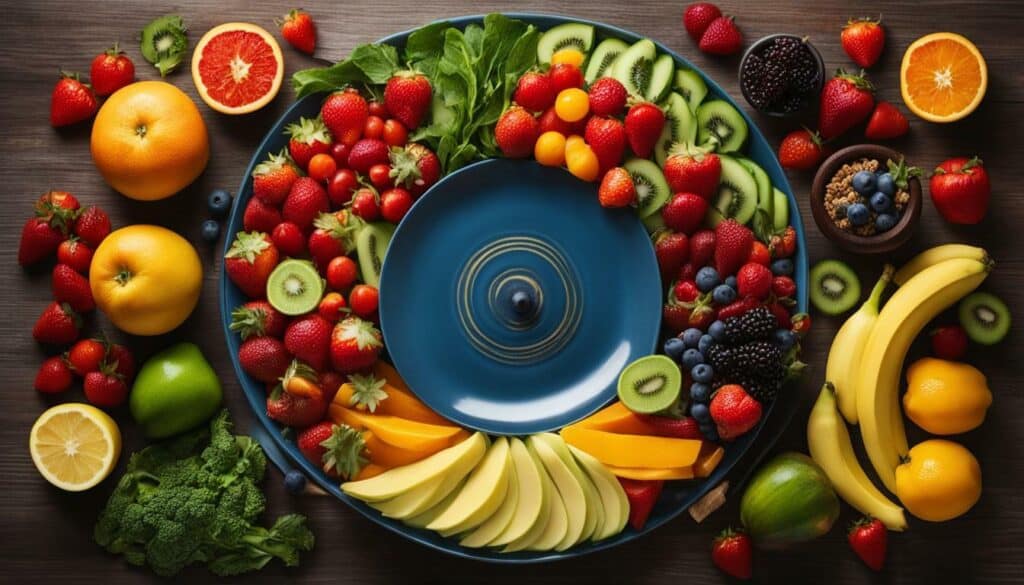
- Choose whole, unprocessed foods as the foundation of your meals.
- Incorporate a variety of fruits and vegetables for their diverse array of nutrients.
- Opt for lean proteins such as poultry, fish, beans, and legumes.
- Include whole grains like quinoa, brown rice, and oats for added fiber and nutrients.
- Experiment with herbs, spices, and seasonings to enhance flavors without relying on excessive salt or sugar.
- Stay hydrated by drinking plenty of water throughout the day.
- Limit intake of added sugars, processed snacks, and unhealthy fats.
- Listen to your body’s hunger and fullness cues, eating mindfully and savoring each bite.
Incorporating nutrient-rich recipes and practicing clean eating habits can have a profound impact on our overall health and well-being. By nourishing our bodies with wholesome, nutritious meals, we can fuel ourselves for success and enjoy the journey to optimal health.
Building a Balanced Diet: Guidelines for Healthy Meal Planning
Planning balanced meals is essential for maintaining a healthy lifestyle. By incorporating a variety of nutritious foods into our daily diet, we can ensure we’re getting the right balance of essential nutrients. Here are some guidelines to help you plan healthy meals:
- Include a variety of food groups: Aim to include foods from all the major food groups, including fruits, vegetables, whole grains, lean proteins, and healthy fats. Each food group provides different essential nutrients that support overall health.
- Portion control: Pay attention to portion sizes to avoid overeating. Use measuring cups or a food scale to accurately portion your meals and snacks. It’s important to strike a balance between getting enough nutrients and maintaining a healthy weight.
- Fill half your plate with fruits and vegetables: Fruits and vegetables are rich in vitamins, minerals, and dietary fiber. They should make up half of your plate at each meal. Opt for a variety of colors to ensure you’re getting a wide range of nutrients.
- Choose whole grains: Whole grains such as brown rice, quinoa, oats, and whole wheat bread are higher in fiber, vitamins, and minerals compared to refined grains. Aim to make at least half of your grain choices whole grains.
- Include lean proteins: Choose lean sources of protein such as skinless poultry, fish, beans, lentils, and tofu. These options are low in saturated fat and provide essential amino acids for muscle growth and repair.
- Limit added sugars and saturated fats: Be mindful of your intake of added sugars and saturated fats. These can contribute to weight gain and increase the risk of chronic diseases. Opt for natural sweeteners like honey or maple syrup and choose healthier fats like avocados, nuts, and olive oil.
Incorporating these guidelines into your meal planning can help you create balanced and nutritious meals. Remember to listen to your body’s hunger and fullness cues and make adjustments to your portions and food choices accordingly.

The Role of Fresh Kitchen Nutrition Resources
Access to reliable kitchen nutrition resources plays a crucial role in our journey towards healthier eating. Having access to accurate and up-to-date information about nutrition can help us make informed choices when it comes to the food we consume. Whether it’s cookbooks, online platforms, or nutrition education programs, these resources provide valuable insights into the nutritional value of different ingredients, cooking techniques, and healthy meal planning.
One useful resource is the availability of nutrition facts labels on food packaging. These labels provide important information about the nutritional content of a particular product, including the amount of calories, fat, carbohydrates, protein, and other essential nutrients. By referring to these labels, we can make more informed decisions about the foods we buy and ultimately consume.
Another valuable resource is the growing number of online platforms and apps that provide a wealth of information on fresh kitchen nutrition. These platforms offer recipes, meal plans, and personalized advice from nutrition experts. They also provide information on portion sizes, ingredient substitutions, and tips for reducing sodium and other unhealthy additives in our meals.
Furthermore, nutrition education programs and workshops can provide us with the knowledge and skills to make healthier choices in the kitchen. These programs cover topics such as understanding food labels, cooking techniques for preserving nutrients, and creating balanced meals. They empower us to take control of our own nutrition and make positive changes in our eating habits.
| Resource | Description |
|---|---|
| Cookbooks | Rich sources of nutritious recipes and cooking tips |
| Online platforms | Provide access to a wide range of recipes, meal plans, and personalized advice |
| Nutrition education programs | Offer knowledge and skills to make healthier choices in the kitchen |
Inspiring Quote:
“When it comes to improving our nutrition, having reliable kitchen resources is like having a compass that guides us towards a healthier lifestyle.”
With the abundance of fresh kitchen nutrition resources available to us, it’s easier than ever to make informed choices and create delicious, nutritious meals. By utilizing these resources, we can take control of our health and embark on a journey towards a balanced and wholesome diet.
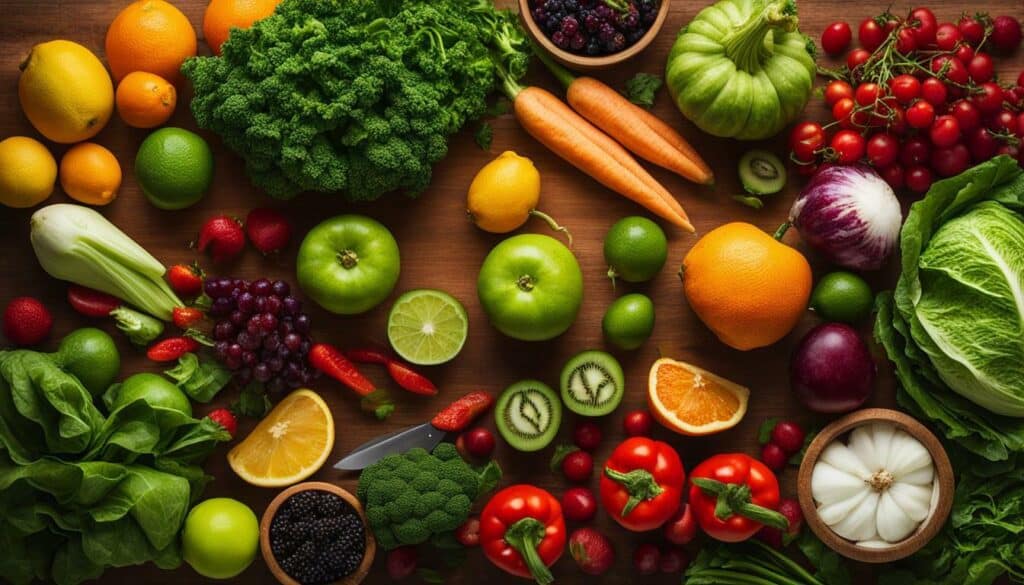
Fresh ingredients are not only flavorful but also packed with essential nutrients that are vital for our well-being. Incorporating these ingredients into our meals allows us to fuel our bodies with the vitamins, minerals, and antioxidants they need to thrive.
When we consume fresh produce, such as fruits and vegetables, we benefit from their high fiber content, which aids in digestion and supports a healthy gut. Additionally, these ingredients are rich in vitamins A, C, and E, as well as potassium and folate, which are essential for maintaining optimal health.
Lean meats, such as chicken and fish, provide a significant source of protein, necessary for building and repairing tissues. They also offer essential amino acids, iron, and zinc, promoting muscle growth and supporting our immune system.
The Nutritional Value of Fresh Ingredients
To help you better understand the nutritional value of fresh ingredients, below is a table highlighting the key nutrients found in commonly used foods:
| Ingredient | Nutrients |
|---|---|
| Spinach | Vitamin K, Vitamin A, Folate, Iron |
| Salmon | Omega-3 Fatty Acids, Protein, Vitamin D |
| Blueberries | Vitamin C, Antioxidants, Fiber |
| Quinoa | Protein, Fiber, Iron |
| Broccoli | Vitamin C, Vitamin K, Fiber |
By incorporating a variety of fresh ingredients into our meals, we can ensure that we are nourishing our bodies with a diverse range of nutrients for optimal health and well-being.
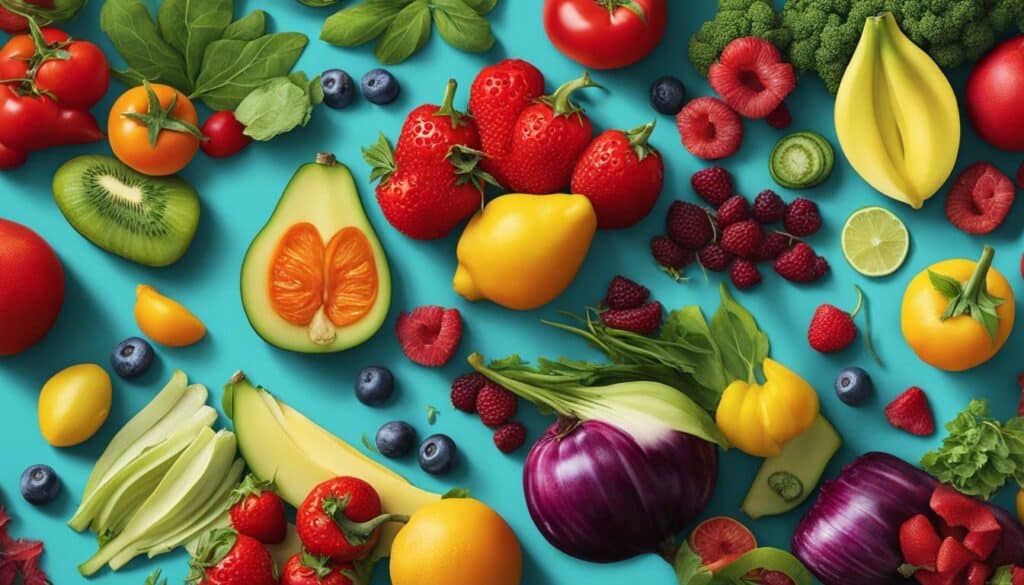
Reducing sodium intake is a healthy choice that can have a positive impact on our overall well-being. By decreasing the amount of salt in our diets, we can lower our risk of high blood pressure, heart disease, and stroke. But how can we limit our sodium intake without sacrificing flavor in our meals? Here are some practical tips and lower-sodium options to help us enjoy tasty and nutritious food.
When cooking, it’s recommended to use less salt than a recipe calls for, and gradually reduce the amount over time. Instead, flavor foods with fresh or dried herbs, spices, garlic, citrus juices or zests, and vinegars. These alternatives add depth and complexity to dishes without relying on excessive salt. Incorporating these flavors can elevate the taste of our meals while reducing sodium content.
When using canned vegetables or beans, opt for low-sodium varieties or rinse them to reduce sodium content. This simple step can significantly decrease the overall saltiness of the dishes we prepare. Additionally, for condiments and seasonings, consider using lower-sodium options available in stores or prepare homemade versions with non-salt seasonings. By making these small changes, we can still savor the rich flavors in our favorite meals while taking control of our sodium intake.
For broths and soups, we have the option to make them at home using non-salt seasonings or choose low-sodium or sodium-reduced options available in the market. Similarly, prepared tomato sauce can be easily made at home using tomato paste and additional flavors. When using butter or margarine, using unsalted versions allows us to enjoy the natural flavors without the added sodium. Making these simple swaps can make a significant difference in our overall sodium consumption.
Here are a few delicious recipes that are lower in sodium:
- Vegetable Quinoa Salad
- Tandoori Haddock
- Curried Lentils
- Sweet Potato and Cauliflower
- Avocado, Beet, and Chicken Tostados
- Stir Fry Beef and Broccoli with Lentils
These recipes not only provide a burst of flavors but also showcase that healthy meals can be both appetizing and satisfying. By preparing lower-sodium dishes, we can take care of our health and enjoy the pleasures of good food simultaneously.
While these tips and recipes can help us reduce our sodium intake, it’s worth mentioning that each individual’s dietary needs may vary. Consulting with a dietitian can provide personalized advice and guidance tailored to our specific goals and conditions. They can help us develop a plan that suits our tastes and preferences while ensuring we meet our nutritional requirements.
| Type of Food | Sodium Content (mg) |
|---|---|
| Bread (1 slice) | 150 |
| Soup (1 cup) | 800 |
| Cheese (1 ounce) | 400 |
| Canned Vegetables (1 cup) | 500 |
| Processed Meats (3 ounces) | 1000 |
Lower-Sodium Alternatives and Homemade Options
By opting for lower-sodium alternatives and preparing homemade versions of condiments and seasonings, we can enhance the taste of our meals without excessive sodium. Reducing sodium intake is a healthy choice, and there are various ways to limit salt in recipes without sacrificing flavor. When cooking, it’s recommended to use less salt than a recipe calls for, and gradually reduce the amount over time.
To add flavor to our dishes, we can turn to fresh or dried herbs, spices, garlic, citrus juices or zests, and vinegars. These ingredients not only provide a burst of flavor but also offer numerous health benefits. For example, herbs like basil, parsley, and rosemary are rich in antioxidants, while spices like turmeric and ginger have anti-inflammatory properties.
When using canned vegetables or beans, it’s advisable to opt for low-sodium varieties or rinse them thoroughly to reduce the sodium content. This simple step can significantly lower the overall sodium intake in our meals. Additionally, it’s beneficial to choose lower-sodium options or prepare homemade versions of condiments and seasonings. This way, we have full control over the ingredients and can create flavorful alternatives without the excessive sodium found in many store-bought products.
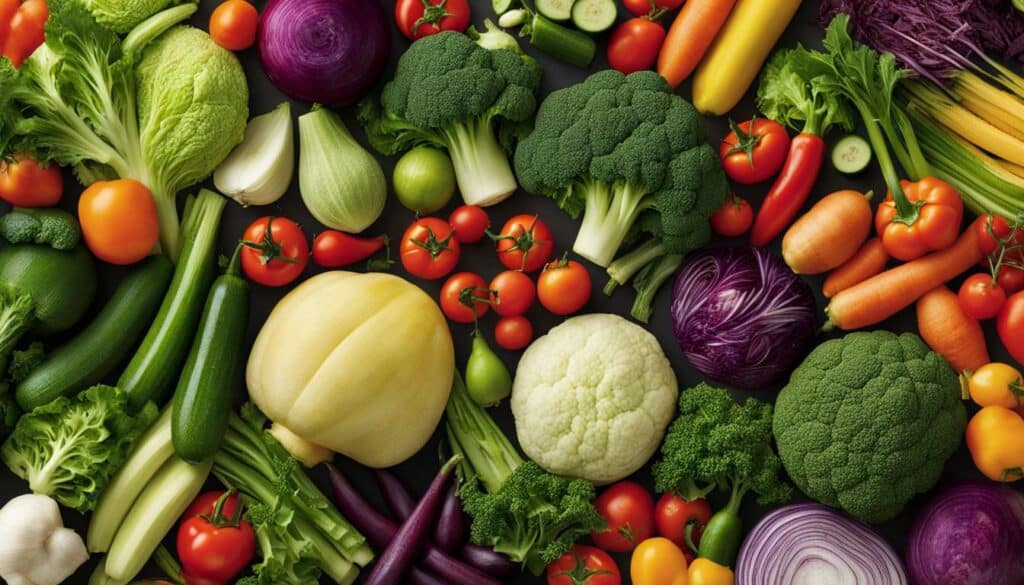
For broths and soups, consider homemade options made with non-salt seasonings or choose low-sodium or sodium-reduced options available in stores. Prepared tomato sauce is another example where we can easily make a homemade version using tomato paste and additional flavors. By making these simple swaps and adjustments, we can enjoy delicious meals that are lower in sodium.
Here are some examples of recipes that are lower in sodium:
| Recipe | Description |
|---|---|
| Vegetable Quinoa Salad | A refreshing and nutritious salad packed with colorful veggies and protein-rich quinoa. |
| Tandoori Haddock | Spice up your fish dish with a flavorful blend of Indian spices, yogurt, and fresh herbs. |
| Curried Lentils | A hearty and aromatic lentil curry that is both satisfying and wholesome. |
| Sweet Potato and Cauliflower | A delicious combination of roasted sweet potato and cauliflower, seasoned with herbs and spices. |
| Avocado, Beet, and Chicken Tostados | A Mexican-inspired dish featuring crispy tostados topped with creamy avocado, roasted beets, and grilled chicken. |
| Stir Fry Beef and Broccoli with Lentils | A flavorful stir fry packed with lean beef, nutrient-rich broccoli, and protein-packed lentils. |
While these recipes are lower in sodium, they are still packed with flavor and offer a variety of nutrients to support a healthy lifestyle. Remember, it’s always a good idea to consult with a dietitian for personalized advice and guidance tailored to your specific needs and goals.
Delicious Low-Sodium Recipes for Healthier Eating
Enjoying delicious meals while reducing sodium is possible with these flavorful low-sodium recipes. By incorporating these dishes into your diet, you can take a step towards better health without compromising on taste. Let’s explore some mouthwatering options:
1. Vegetable Quinoa Salad
This colorful salad is packed with fresh vegetables and hearty quinoa, making it a nutritious and satisfying meal. The combination of crunchy cucumbers, bell peppers, cherry tomatoes, and leafy greens creates a refreshing dish that is perfect for summer. The tangy dressing, made with citrus juices and a touch of olive oil, adds brightness without the need for extra salt.
2. Tandoori Haddock
If you’re a fan of Indian cuisine, this low-sodium recipe is a must-try. The delicate haddock fillets are marinated in a flavorful blend of yogurt, spices, and herbs, then grilled to perfection. The result is a dish that is rich in taste and texture, without the added sodium. Serve it with a side of steamed vegetables or a fresh salad for a complete and satisfying meal.
3. Curried Lentils
Lentils are a fantastic source of protein and fiber, and this curried lentil dish is a delicious way to enjoy their benefits. The aromatic blend of spices, including turmeric, cumin, and coriander, creates a depth of flavor that will keep you coming back for more. Pair it with whole grain rice or naan bread for a hearty and nutritious meal.
These are just a few examples of lower-sodium recipes that can add variety and flavor to your diet. By exploring different ingredients and cooking methods, you can create meals that are both healthy and satisfying. Remember, reducing sodium intake is a positive step towards better health, and consulting with a dietitian can provide personalized advice tailored to your specific needs and goals.

| Recipe | Calories | Sodium (mg) |
|---|---|---|
| Vegetable Quinoa Salad | 250 | 150 |
| Tandoori Haddock | 300 | 180 |
| Curried Lentils | 200 | 120 |
Seeking Personalized Advice from a Dietitian
Consulting with a dietitian can offer personalized advice and ensure our dietary choices align with our individual requirements. While general nutrition information is valuable, a dietitian can provide tailored guidance based on our specific needs and goals. Whether we’re looking to manage a specific health condition, lose weight, or simply improve our overall well-being, a dietitian can provide the expertise and support needed to make sustainable and effective changes to our diet.
One of the main advantages of consulting with a dietitian is the personalized approach they offer. They take into account our unique dietary preferences, lifestyle factors, and health history to create a customized plan that fits our needs. By analyzing our current eating habits and nutritional status, a dietitian can identify areas where improvements can be made and provide practical recommendations that are realistic and achievable.
A dietitian can also help us navigate through the vast amount of nutrition information available today. With so many fad diets and conflicting advice, it can be overwhelming to determine what’s truly beneficial for our health. A dietitian has the knowledge and expertise to separate fact from fiction, providing evidence-based information that is tailored to our individual circumstances.
Additionally, working with a dietitian provides ongoing support and accountability. They can help us establish realistic goals, track our progress, and make adjustments as needed. They can also offer practical tips and strategies to overcome obstacles and maintain motivation on our journey towards better health.
When it comes to our health, seeking personalized advice from a registered dietitian is a wise investment. Their expertise, guidance, and support can empower us to make informed choices, optimize our nutrition, and achieve our health and wellness goals. So, if you’re looking to improve your diet and overall well-being, consider consulting with a dietitian and take the first step towards a healthier and happier you.
| Key Benefits of Consulting with a Dietitian | |
|---|---|
| Personalized Guidance | Receive tailored advice based on your individual needs and goals. |
| Expert Knowledge | Access evidence-based information and navigate through nutrition misinformation. |
| Support and Accountability | Receive ongoing support, motivation, and practical tips to stay on track. |
| Realistic and Achievable Goals | Create a customized plan that fits your lifestyle and can be maintained long-term. |
Conclusion
By unlocking fresh kitchen nutrition information, we empower ourselves to make healthier choices and enjoy the benefits of a well-nourished body and mind. Throughout this article, we have explored the importance of fresh kitchen nutrition information and how it can help us achieve a balanced diet.
We have learned about the benefits of nutrient-rich recipes and clean eating tips, which enable us to maximize the nutritional value of our meals and support our overall well-being. Additionally, we have discovered guidelines for healthy meal planning, ensuring that we create nutritious and satisfying meals that align with our health goals.
Understanding the nutritional value of fresh ingredients has been emphasized, as it allows us to make more informed decisions about the food we consume. We have also explored practical tips for reducing sodium intake without compromising on taste, such as using lower-sodium alternatives or preparing homemade options.
Lastly, we have provided a selection of delicious low-sodium recipes that showcase how healthy meals can be both flavorful and satisfying. However, it is important to note that while general nutrition information is valuable, consulting with a dietitian for personalized advice is highly recommended. They can provide guidance tailored to our specific needs and goals, ensuring we make the best choices for our individual health journey.
In conclusion, armed with fresh kitchen nutrition information and the resources available to us, we have the tools to embark on a journey towards a balanced and nutritious diet. Let’s take control of our health by making informed choices and embracing the benefits of a well-nourished body and mind.
FAQ
Q: How can I reduce sodium intake in my recipes without sacrificing flavor?
A: It’s recommended to use less salt than a recipe calls for and gradually reduce the amount over time. Instead, flavor foods with fresh or dried herbs, spices, garlic, citrus juices or zests, and vinegars.
Q: What can I do to reduce sodium when using canned vegetables or beans?
A: You can opt for low-sodium varieties or rinse them to reduce the sodium content.
Q: Are there lower-sodium options for condiments and seasonings?
A: Yes, you can use lower-sodium options or prepare homemade versions with non-salt seasonings.
Q: How can I make lower-sodium broths and soups?
A: You can make them at home using non-salt seasonings or choose low-sodium or sodium-reduced options.
Q: Can I make my own tomato sauce without added sodium?
A: Yes, you can prepare tomato sauce at home using tomato paste and additional flavors.
Q: What type of butter or margarine should I use to reduce sodium?
A: Use unsalted versions of butter or margarine.
Q: Can you provide some examples of lower sodium recipes?
A: Sure! Some examples include Vegetable Quinoa Salad, Tandoori Haddock, Curried Lentils, Sweet Potato and Cauliflower, Avocado, Beet and Chicken Tostados, and Stir Fry Beef and Broccoli with Lentils.
Q: Should I consult with a dietitian for personalized advice?
A: Yes, it’s recommended to consult with a dietitian for personalized advice tailored to your specific needs and goals.
How Can Nutrition One Help Me Make Healthier Choices in the Kitchen?
When it comes to making healthier choices in the kitchen, nutrition one: your health ally can be a valuable resource. With their expertise in nutrition, they provide guidance on selecting nutritious ingredients, creating balanced meals, and incorporating healthier cooking methods. Their wide range of tips and advice can support you in making positive changes to your diet and overall well-being.

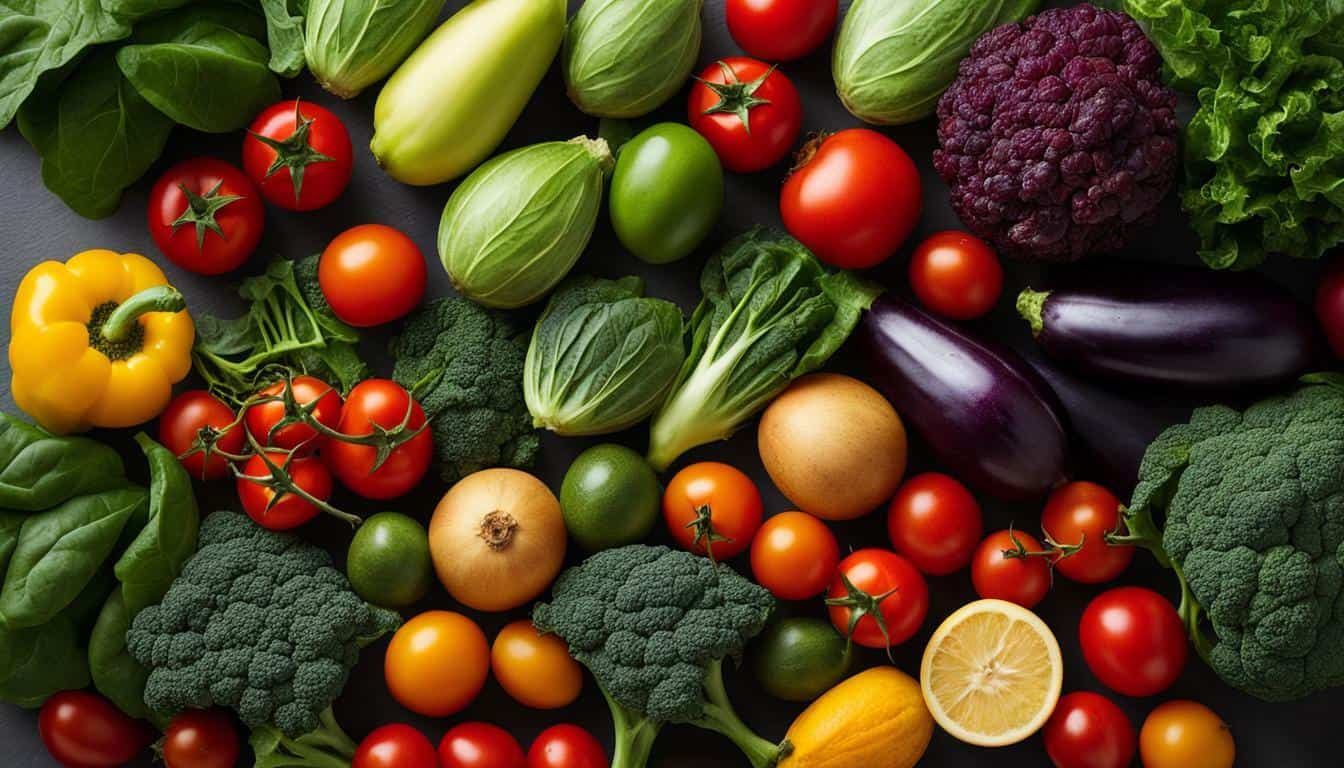



Leave a Reply